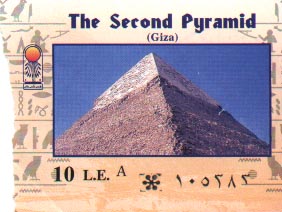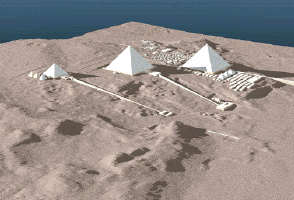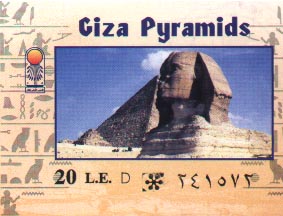


Anyone who thinks of Egypt, probably thinks of the pyramids on the Giza plateau. After all, they are the only remaining Wonder of the Ancient World. Many people even go so far as to think that all pharaohs were entombed inside a pyramid as a mummy. It seems obvious that a god-like leader ruling over a central government linked to an army and a religion would be the logical genesis of such wonders. By today's standards of opportunity, even you and I might enjoy the right to a pyramid burial! On the flip side, it's easy to forget that many of Egypt's pharaohs were actually buried in the the Valley of the Kings, hundreds of miles south near Thebes, the modern day city of Luxor. Only early Pharaohs built pyramids, probably because they realized that pyramids were edifices of their egos. Richly adorned ego ads make easy targets for grave robbers. Happily, lust for the eternal after-life trumped raw ego and many of Egypt's treasures were spared from the robbers.
If you've been trapped thinking of all uharaohs entombed in pyramids, it's probably because the history of Egypt is so vast. The first pyramids date back more than 4600 years, and Egypt's recorded history even goes back even farther, over 5000 years. This record outdates Plato, Buddha, Christ, Moses and countless other heroes of ancient history. Two hundred years of US history is merely a drop in the bucket of time by comparison. Ancient Egypt gave birth to writing, stone construction, and the idea of a nation-state. In her old age, Ancient Egypt even inspired the Greek and Roman philosophers with the Great Library of Alexandria. Her influence is still pumping through our veins today.
The recorded history of Egypt might be categorized as follows:
3100-332BC: Pharaonic Egypt
332-30BC Alexander & Ptolemaic Era
30BC-AD683 Roman Rule
640-1517AD Arab Conquest:
1517-1882AD Ottoman Turkish Rule, and Napoleon's visit
1882-1952AD British Occupation
1952+ Independent Egypt
So, nearly 3000 years were ruled under the watch of Pharaohs. Here's a more detailed view:
3100BC: Narmer unifies upper and lower Egypt
3050-2686BC: First two Pharaonic Dynasties
2686-2647BC: Zoser (Djoser) builds the famous step pyramid
2613-2589BC: Sneferu builds the "Bent Pyramid" after numerous other attempts
2589-2566BC: Dynasty IV, Khufu builds the great pyramid at Giza
2181-2049BC: First Intermediate Period
2134-1782BC: The Middle Kingdom
1782-1650BC: Second Intermediate Period
1570BC- Dynasty XVIII begins along with the first tombs in Valley of the Kings
1498-1483BC Hatshepsut, a woman Pharaoh, Rules Egypt
1386-1349BC: Amenhotep III; peak of new kingdom
1350-1134BC: Akhenaten the heretic rules
1334-1325BC: Tutankhamen, the boy king, rules
1279-1212BC: Ramses the Great (and the Passover?)
1080-945BC: Dynasty XXI-Priest Kings rule
945BC- Foreign Kings begin to rule
30BC- Death of the "movie star" Cleopatra
Only about 500 years of Pharaonic history involved the early Pyramids. In fact, the pyramids on the Giza plateau only span a few hundred years. After the Pyramids, Pharaohs were buried in the Valley of Kings during a span of about 700 years. After that, tradition started running a new track. "Foreigners" become part of Egypt's "melting pot" history. For example, Cleopatra's ancestors were of Greek (Ptolemaic) descent. By the time of Cleopatra, the idea of Pyramids and the Valley of the Kings had long been abandoned.
Supposedly, the idea of a pyramid started with a mastaba. The mastaba is a bench-like rock that covers a tomb. In the really old days, there was a problem with jackals (read Anubis, the mummification God). When a corpse was buried, jackals would locate the stench and unearth the deceased as a meal. Ancients dispelled the jackals with the Mastaba. No way could a jackal dig through a solid rock covering. About the time of Zoser, the step pyramid was invented as stacks of successively smaller mastabas. One thing led to another. . .after considerable trial and error. . .and the "modern" pyramid was engineered 4500 years ago by Sneferu and his descendents. Khufu built the "great" pyramid.
So, we took our modern journey to the necropolis at the Giza plateau and visited the ancient pyramids. I was reminded of Mark Twain's visit 100 years ago when he wrote that: "tourists suffer a torture that no pen can describe from the hungry appeals for baksheesh that gleam from Arab eye." Ours was no exception. Moved as we were by the ancient accomplishments, the current state of mankind is just as entertaining!
Our approach to the Giza Pyramids was accompanied by tour buses and countless local entrepreneurs angling for a $$$ fix. As we passed a parked camel, I made the mistake of casting my eyes over the curiosity. We were soon invited to take a picture. The girls climbed aboard and I snapped a photo. After the deed was done, pricing negotiations commenced with an uncomfortable vengence. Shame on me for sneaking a peek! I'd completely forgotten the rule, "if you don't want it, don't look at it."
We then wondered towards the pyramid. It was impressive indeed! Blocks were about head high and they reached into the sky. Tourists aren't allowed to climb on the Pyramids, but it's possible to pay one of the tourist police for "help." In the picture on the right above, locals are loitering a few blocks up the Pyramid. Locals can easily negotiate with tourist police in native tongue, so they were the most likely to be climbing.
The girls wanted to enter the Pyramid, but there's a limited number of tickets sold each day. Their only choice was the "second pyramid." The afternoon sun cast shadows over the great pyramid as we approached the smaller second pyramid. Just as we arrived, a camel was rising off its knees with two elderly Japanese tourists aboard. The camel grunted with a protest, but the owner slapped him into submission. As the camel rose to about 6 feet, the saddle suddenly slipped and the unfortunate tourists fell from the beast. The victims landed on their backs with a loud thud accompanied by the wheezing gasp of wind bellowing from lungs. It probably hurt as bad as it sounded. A crowd of camel riders quickly encircled the scene. Once the tourists regained their breath, the camel riders proclaimed something like "Ma'a ssalama," or perhaps "Mashallah." Then, the camel riders quickly vanished. Tourist police replaced the riders. They swaggered in with a small Toyota police truck. The tourist police began surveying the situation, hoping the elderly Japanese tourists might communicate something in local vernacular, or at least attempt to mobilize themselves. Meanwhile, the girls embarked into to the tomb. Although Giza has a medical facility, I didn't see anything like an ambulance while I waited for the girls to explore the cramped spaces inside the pyramid. When Vijay finally emerged, she complained aches and pains as if she'd just had a good workout at the gym. Good thing that medical services in Egypt are easily accessible!
From the pyramid, we left the injured tourists to "Inshallah" and wandered down the causeway to the Valley Temple at the feet of the great Sphinx. Even with the sun setting, tourist crowds were still plenty thick. The approach to the Sphinx via the temple involved a shoulder-to-shoulder pilgrimage through the sardine packed tourist crowds. After exiting the narrow doors of the temple, the Sphinx presented itself in full majestic glory. The Sphinx's missing nose and beard were conspicuous in absence. It brought to mind Dr. Brier's comments about the Sphinx's beard residing far from home in the British Museum and the nose a victim of Turkish target practice. The missing parts and the herding tourist crowds made me wonder what the contemporary Egyptians might think. That thought crowned a vast span of time and our first full day in Egypt.
We rested well that evening under the shadow of the great Pyramid at the Mena House. The next morning, we followed the footsteps of the ancient pharaohs to the upper Nile. Click below, and join us on the next leg of our journey.